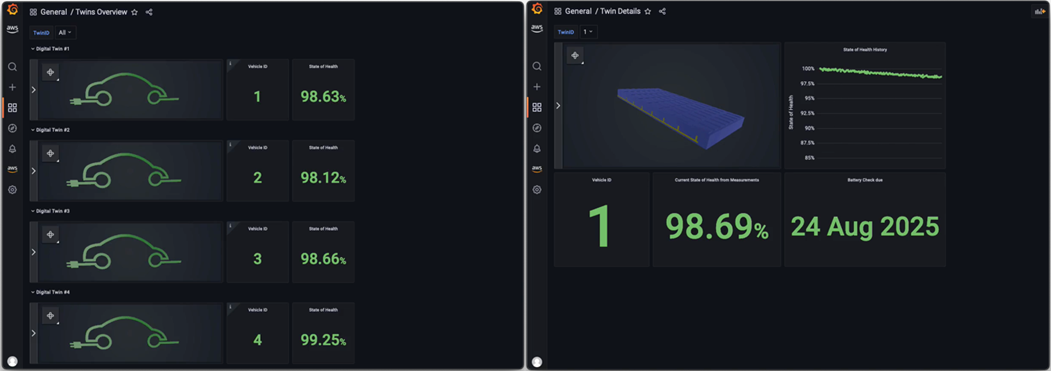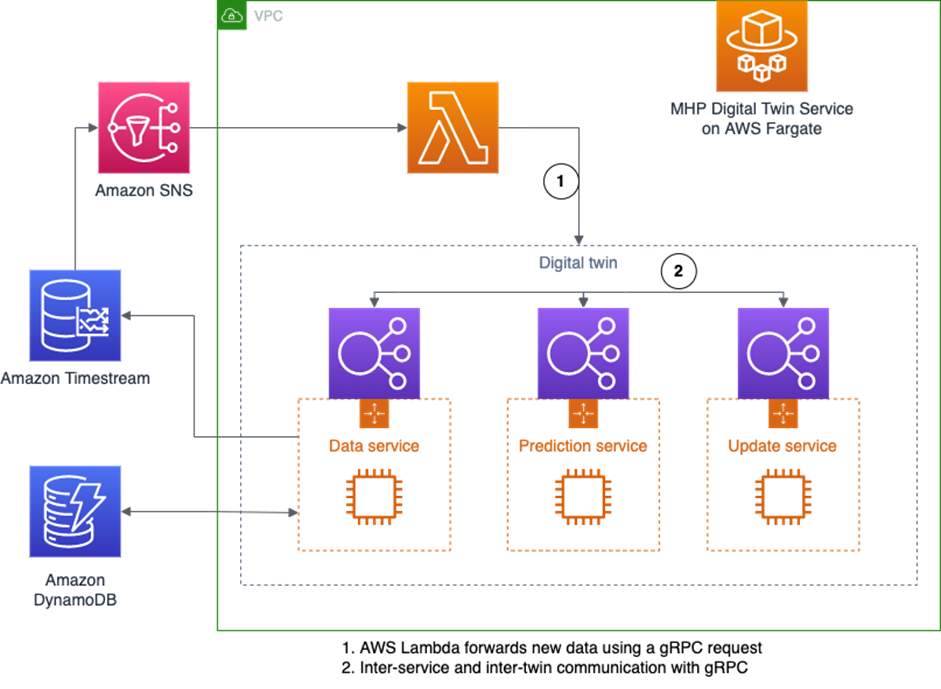AWS Partner Network (APN) Blog
Using Digital Twins to Drive Electric Vehicle Battery Insights with MHP and AWS
By Markus Baumann, Pouyan Asgharzadeh, and Janosch Henze – MHP
By Adam Rasheed, David Sauerwein, Shankar Subramaniam, Robert Meyer, Aditi Gupta, and Seibou Gounteni – AWS
 |
| MHP |
 |
Today’s vehicles are moving beyond a simple means of transportation and evolving into connected Internet of Things (IoT) devices that redefine the traditional models of vehicle ownership and usage.
This change of vision is altering the approach to solving challenges related to mobility. The automotive industry is looking to artificial intelligence (AI) accelerated “digital twins” to address challenges such as smart charging, battery health monitoring, predictive maintenance, fleet management, and the circular economy.
A digital twin is a virtual representation of a physical system that is dynamically updated with data to mimic the structure, state, and behavior of the physical system.
Given the breadth of digital twin use cases, Amazon Web Services (AWS) has proposed a 4-level index to help customers categorize their use cases and understand the services, technologies, data and models needed to build and deploy their digital twin at scale.
In 2022, MHP announced a Strategic Collaboration Agreement with AWS to further support cloud transformation in mobility and manufacturing. MHP is an AWS Advanced Tier Services Partner that brings years of expertise in the mobility and manufacturing environment to the collaboration, with a focus on cloud strategy, architecture, development, migration, and operations challenges.
In this post, we share the results of MHP’s efforts working with AWS to build and deploy a Level 4 digital twin for an electric vehicle, as a means for monitoring and analyzing batteries of electric vehicles (EVs) utilizing live data, fleet knowledge, and AI.
We’ll share a use case of battery health and performance management by learning driver behavior (driver twin) and battery characteristics (battery twin) from the fleet. We’ll also describe the industry problem and explore the technical solution and reference architecture built and deployed on AWS.
The Electric Vehicle Battery Challenge
Management and optimization of batteries in electric vehicles is central to battery producers, original equipment manufacturers (OEMs), and users.
Answering questions about how batteries can be charged to optimize long-term health and the residual value of an EV are challenging because each electric vehicle is exposed to different environmental conditions and usage patterns.
As a result, every battery is unique. Therefore, its operational performance needs to be calculated individually, based on its specific service history. Monitoring and predicting characteristics of batteries such as the state of health (SoH) and state of charge (SoC) addresses topics such as range anxiety, predictive maintenance, residual value, and second life for electric vehicles.
Today’s physics-based models developed for calculating such parameters in batteries have two main downsides: low accuracy and high computation costs. These models either over-simplify or neglect key factors such as driver behavior, or they are overly complex in attempting to numerically solve the detailed battery electrochemistry.
A digital twin using a hybrid physics and data-driven approach allows organizations to create operational models that can run in near-real time and include the effects of real-world factors by leveraging the operational vehicle data.
Solution Showcase
The solution detailed in this post addresses several challenges. It needs to be:
- Scalable to a large number of vehicles.
- Modular to ensure additional components can be added as the digital twin becomes more complex.
- Able to provide a scalable mechanism to automatically recalibrate the models of individual EVs to ensure they continue to make accurate predictions.
The screenshot in Figure 1 below is of the deployed solution for a fleet of four vehicles. The following video will also help you understand MHP’s platform for digital twins.
The state of health of batteries is a direct indicator of residual value in electric vehicles. SoH degradation is strongly dependent on usage patterns, environmental conditions and battery management.
Our showcase focuses on predicting the SoH of the battery of an EV based on driving patterns. We model the electric vehicle using two digital twins—the first models the driver and the second models the battery. Both digital twins are fed with synthesized data, using artificial driver behavior data as well as degradation data for batteries.
The driver digital twin predicts when the next trip will take place, how long the trip will be, and other driver-based information using a sampling-based approach on behavior modelled using Kernel density estimation. The battery digital twin uses the data from the driver digital twin to predict the future state of health of the battery, modeling the degradation of the battery.
Figure 1 – Screenshot of deployed solution for a fleet of four vehicles.
Services Architecture
The architecture shown here uses AWS IoT FleetWise to ingest simulated vehicle data into an Amazon Timestream database. The data is consumed by the custom-built MHP digital twin service, which stores the prediction metadata in Amazon DynamoDB and the predictions results back into Amazon Timestream.
Prediction results are fed into AWS IoT TwinMaker and are used in Amazon Managed Service for Grafana to allow a fleet operator to monitor the state of health and other vehicle-based information in an easy-to-use dashboard.
Figure 2 – Overall service architecture.
The MHP digital twin service is core to the Level 4 digital twin solution and handles passing operational data to the digital twin model, running the model, calculating the model error, and recalibrating the digital twin model when needed.
The service leverages model calibration techniques developed as part of the aws-do-pm open source framework. Figure 3 shows the architecture of the MHP digital twin service.
The MHP digital twin service has two key features to enable a modular digital twin that can grow as new components are added.
First, a digital twin is divided into submodules, each of which is represented by its own digital twin. Each child digital twin interacts with its siblings to synthesize the behavior of their parent twin. For example, a battery can be modelled using digital twins of its cells, or a car can be modelled using digital twins of all its different components. The modeling depth depends on the use case and on the modeling techniques available.
Second, each digital twin is divided into three modules as shown in Figure 3. These modules reflect the basic requirement of a Level 4 living digital twin to use measurements to update the model to improve predictions as new data become available. To enable this, every digital twin consists of a data service, update service, and prediction service.
Figure 3 – Architecture of the digital twin service.
The data service handles data ingestion into the model. It’s also responsible to write the results of the prediction back to the databases and to serialize the model parameters.
The update service can perform an initial training, update the whole model, or perform a Bayesian calibration on the model whenever the prediction error becomes too large.
This Bayesian update is based on Unscented Kalman Filters (UKFs), a method for parameter estimation of non-linear systems that’s applied in fields ranging such as guidance, navigation, and control of vehicles to robotic motion planning and trajectory optimization. UKFs are also central to the aws-do-pm framework for predictive modeling.
The three modules are developed as individual tasks deployed on AWS Fargate, and each service uses an Application Load Balancer to ensure scalability. Within the AWS Fargate deployment the communication is handled via gRPC, a Remote Procedure Call (RPC) framework, to pass messages between the individual twin services and modules.
New external data is collected in an Amazon Simple Notification Service (SNS) topic consumed by an AWS Lambda function. The Lambda function forwards the new data to the respective digital twin using gRPC requests.
Summary
In this post, we shared how MHP is working with AWS to build a modular, scalable digital twin solution to address the challenges of the electric vehicles, and specifically EV battery performance.
This solution is a Level 4 living digital twin per the 4-level index proposed by AWS. To learn more, please read MHP’s whitepaper and watch the webinar.
While the above is an example use case from automotive industry, with digital twin the possibilities are limitless.
MHP – AWS Partner Spotlight
MHP is an AWS Advanced Tier Services Partner founded in 1996 as a subsidiary of Porsche AG. MHP’s approach comprises management and IT consulting for the automotive sector and beyond, as well as providing in-depth process know-how that enables customers to shape a better future for their business.



